
© Sebastian Cwikla. (Click image for larger version)
Baltic Dance Theatre
The Netherlands 1: Clash, Fun, Light
Gdansk, Baltic Opera House
13 April 2014
www.baltyckiteatrtanca.pl
The Baltic seaport city of Gdańsk has been the prized rope in a centuries-old tug-of-war between the nations to east and west, a metaphor with particular relevance to recent and ongoing events in eastern Ukraine. For almost one third of its thousand-year existence, Gdańsk has been a Teutonic city (governed first by Prussia, through the Weimar Republic and onto Hitler’s Germany). In these times and during intervening brief periods of autonomy as a free city state it was known as Danzig (still the German name for the city). Following the end of the Second World War, Gdańsk was placed firmly on the eastern side of the “Iron Curtain” in the People’s Republic of Poland. Today, its citizens will attest that their war lasted for 50 years, eventually ended by the rise of the Solidarity movement, emerging under the leadership of Lech Wałęsa from within their own shipyards, which finally led to the end of Communist rule in 1989.
Given Gdańsk’s frequent subservience to neighbours of closer proximity, I was surprised to learn that there have also been very profound Dutch influences on the city, primarily exercised through the supremacy of the Dutch sailing fleet trading along the coast of Northern Europe from the 15th to the 17th centuries. The influence of The Netherlands has left a permanent mark on the architecture of Gdańsk, which can be seen in the narrow Dutch houses – with their colourful facades and ornately rounded gables – that still proliferate throughout the old city. And now there is a new cultural inspiration drawing the Netherlands back to Gdańsk through the choreographic talent and procuring skills of Izadora Weiss, artistic director of the Baltic Dance Theatre.

Dancers: Paulina Wojtkowska, Tura Gómez Coll, Sayaka Haruna, Michal Labus and Daniel Flores Pardo.
© Sebastian Cwikla. (Click image for larger version)
Her development as a choreographer has been mentored by Jirí Kylián at the Nederlands Dans Theater where Weiss spent considerable time around the turn of the century undergoing choreographic training with the man she calls “maestro” as well as with other choreographers, including Hans van Manen, Ohad Naharin and Paul Lightfoot. Arising from this experience, Weiss has based the development of her emerging company on the NDT model.
Kylián has already transferred some of his work to BDT and this process will continue with a double-headed premiere on successive evenings in November, beginning with a programme of Kylián’s Sarabande and Falling Angels (joined by a new work entitled Body Master by Weiss) followed by a triple bill of Clash by Patrick Delcroix (former NDT dancer and Kylián’s assistant) and two more new works by Weiss, respectively entitled Fun and Light, the latter enhancing the Dutch theme with its inspiration from Vermeer’s painting of The Milkmaid, specifically channelled through the words of a poem about the painting by the Nobel Prize-winning poet, Wisława Symborska.
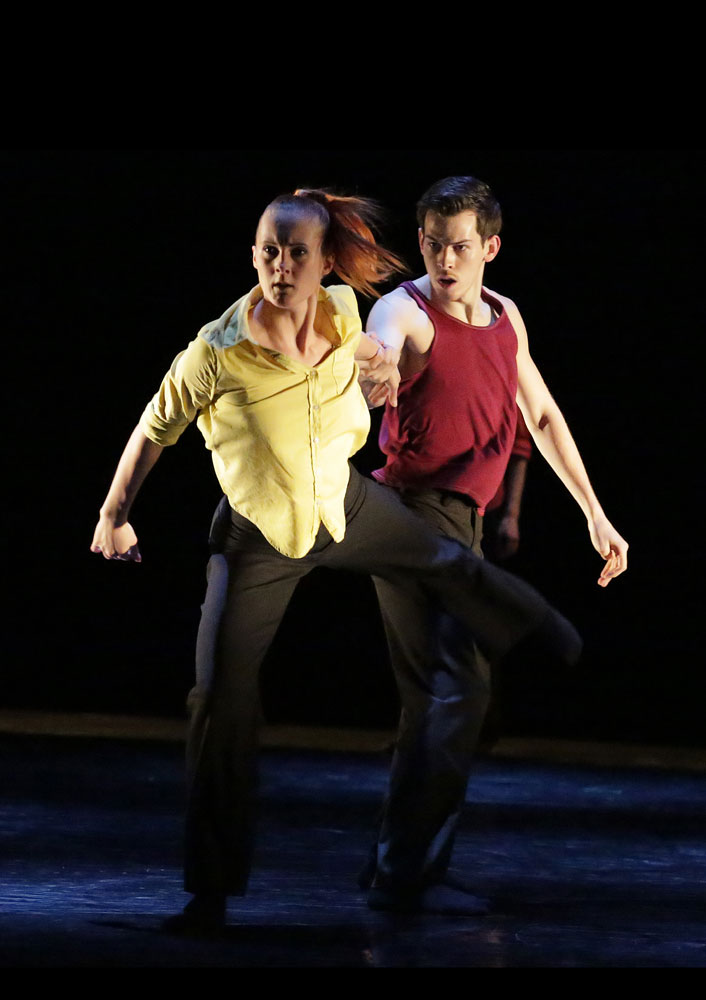
© Sebastian Cwikla. (Click image for larger version)
Although this latter programme is not due to premiere officially until November, it has had a spring season of previews at the Baltic Opera House, which I was fortunate to catch at the end of this brief run. Originally intended as a double bill of Clash and Light, Weiss then decided – late into the preparations – that the overall programme was too short and so she made Fun with no budget (the only cost being the production of three new costumes) and in just over a week. It proved to be excellent intuition on her part, not simply in terms of securing a more appropriate programme length but because the new work acts as a much-needed bridge to connect the two substantial – but very different – pieces that open and close the evening.
Delcroix created Clash, in 2008, for Ballet Junior Genève (a pre-professional dance company based on graduates from L’Ecole de Danse de Genève). It is fifteen minutes of pure dance, abstractly set to the atmospheric clicks, beats and violin strings of Murcof’s electronic music, which ranges from quietly soporific to raucously bombastic. Murcof, by the way, is the performing and recording name of the Mexican musician, Fernando Corona.

© Sebastian Cwikla. (Click image for larger version)
The opening tableau has nine girls arranged like pegs on a solitaire board, in three concentric diagonals, each centred on their own circle of light and moving within this personal kinesphere by spinning, stretching and reaching with or spreading their arms, generally in harmonious symmetry. In due course, they are joined by six men, dancing more freely within the lines of their counterparts who now remain frozen in separate and distinct poses. As repeated violin phrases begin to dominate the music, two couples are framed within three sides of a square by the remaining dancers, performing simultaneously but in separate duets. A process of regeneration is achieved as the dancers in the centre leave to be replaced by others from the outer cordon. A sudden change of pace comes halfway through the piece, prefaced by a violent increase in tempo and volume of the music, and the choreography again settles on the uniform movements of the nine girls dancing in formation.
This is a work that focuses attention on the geometric, fluid movement patterns that Delcroix establishes through the interactions of his fifteen dancers. Towards the end, he achieves a kind of ripple effect as pairs of dancers pick up the central rhythms in partnered heterosexual duets, incorporating a variety of lifts, suspended balances and pirouettes. The other dancers are always moving on the periphery but gradually they give way to a final atmospheric duet between Amelia Forrest and Michal Łabuś that concludes a flowing and absorbing dance classic. The choreography presents a constant challenge for the dancers both in terms of the strength of technique required and in the discipline of harmonising movements throughout the work. The strong and diverse Baltic ensemble succeeded in nailing this technique and synchronicity with remarkable consistency.
As mentioned earlier, Fun was a late addition to the programme although nothing about it belies the fact that it was made so hastily. Utilising Vivaldi’s music as played by Nigel Kennedy (music that Weiss has used before in Four Seasons, a work she made for the Malta Festival in 2000) and augmented by inserts from Paganini and Jordi Savali, Fun is a dance fantasy on the subject of courtship. Hanna Szymczak has cleverly adapted her set design for Light to provide a diagonal wall with a window and wardrobe, both of which have important roles to play.

© Sebastian Cwikla. (Click image for larger version)
Weiss extends the eternal triangle into a five-sided polygon, with three women and two guys. The girls’ movement is generally soft and romantic while the boys (Daniel Flores Pardo and Michal Łabuś) are macho and self-absorbed. Łabuś, in particular, is clearly not a man to be trifled with. The last scene brings Sayaka Haruna (last seen as a fascinating Puck in Weiss’s glorious production of A Midsummer Night’s Dream) centre stage for a haunting solo, danced to the lonely violin of Julia Fischer playing Paganini’s Caprice.
One is left with the impression that in this swiftly-composed piece, Weiss is concluding that a woman’s solitude is sometimes preferable to being subservient to the self-interest of a macho male ego. In any event, Fun seems to be at the permanent edge of irony. There is no doubting that this is the weakest work in the trio (unsurprisingly given the rush of its late addition to the programme) but it is musically, choreographically and theatrically interesting and I will be keen to see how it develops prior to the official premiere, later this year.
The big event was Light, set to the music of Phillip Glass and based upon Symborska’s poem about “that woman from the Rijksmuseum” (a reference to the servant girl that Vermeer painted pouring milk). In essence this brief poem asserts that so long as she continues to pour the milk, “day after day, from the pitcher to the bowl” the world will not end, which I guess is an allegory for artistic and cultural values being the world’s best chance at survival.
In a similar way to how Peter Webber created a feature film around Vermeer’s Girl with a Pearl Earring in 2003, Weiss uses the painting of The Milkmaid to create a fantasy of all that surrounded the subject at the time that she poured her milk. Since this is effectively a preview, I don’t want to spoil the plot twists other than to reveal that this is a fascinating exercise in developing the insidious cancer of evil from the smallest rupture in the fabric of normality.

© Sebastian Cwikla. (Click image for larger version)
Light is a dark and compelling work that continues Weiss’s predilection for mixing concurrent action on different parts of the stage. Just as in A Midsummer Night’s Dream where she had peripheral parts of the narrative enacted upstage while the main events were taking place downstage, here she has a platform on which dancers perform, while others simultaneously dance to the side. This effect creates a work that is hard to assimilate at one viewing since it is virtually impossible to see all that is happening at the same time.
The curtains open onto a truly amazing coup de theatre with the Vermeer painting faithfully replicated on the stage and so effectively that it brings spontaneous applause from the audience. Everything in Szymczak’s stage design is perfect, from the angle of the window, the colour scheme of the bare walls and the cloth-laden table to the costume worn by the maid – played by the 20 year-old American dancer, Amelia Forrest. She pours the milk gently – it is surprising how long one pitcher of milk lasts when decanted so slowly – while singing unaccompanied, in Dutch. This young performer has a noteworthy combination of talents! Gradually, the audience becomes aware that she is being watched by the master of the house (Filip Michalak) and it is his attentions that lead to a swift and violent change of pace.

© Sebastian Cwikla. (Click image for larger version)
There are several strong narrative and dance portrayals in Light. Beata Giza is especially powerful as the house’s vengeful Mistress; Franciszka Kierc dances sublimely as the Girl (I suppose a kind of modern-day allegory for the Milkmaid); Sayaka Haruna and Tura Gómez Coll are an arresting pair of devils, clad in red bras and shorts; and Łabuś continues his very effective tough guy act as ‘The Evil One’. Former Rambert School graduate, Harry Price, appears as one of the four ‘Violators’. From the role nomenclature, one can immediately see that the serene calmness of the milk-pouring gives way to something much more sinister. Although I loved the opening sequences and understand the reasoning for the possession and destruction of this image by evil, I was lost by the accompanying move away from obviously rooting the narrative in the time of the painting.

Foreground: Franciszka Kierc (Girl), Harry Price ( a Violator) and Sayaka Haruna (a Devil). In the background are Daniel Flores Pardo, Bartosz Kondracki, Filip Lobl and Hodei Iriate Kaperotxipi.
© Sebastian Cwikla. (Click image for larger version)
The decision to create a middle work between the abstract pure dance of Delcroix and the very dark tale that unravels in Light was a good one. It helped to create a more balanced evening of dance than would otherwise have occurred. It also created a busy night for some of the hard-working BDT dancers, notably Łabuś (who performed a significant number of lifts throughout the evening), Coll, Haruna and Pardo, each of whom appeared in all three pieces (and with only a two-minute pause between Fun and Light).
The first work showed how Kylián’s influence has already spread, since it would be easy to imagine that Clash is itself a work by the Czech maestro. The latter two works give further supporting evidence to the case for Izadora Weiss being considered as one of the most imaginative and exciting modern choreographers of the new generation. On returning from Poland, I discovered that she had been given a special award by the City of Gdańsk for her “artistic achievements” and A Midsummer Night’s Dream was voted as the best theatrical performance seen in Gdańsk in 2013. These hometown plaudits are worthily achieved but it is high time that her extraordinary work is seen farther afield. Her choreography and this excellent company deserve to go global.
Note – the author attended this performance as a guest of the Baltic Opera House.






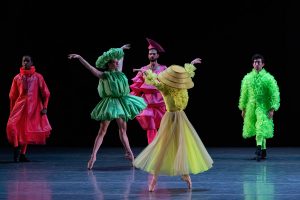
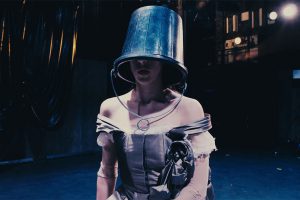

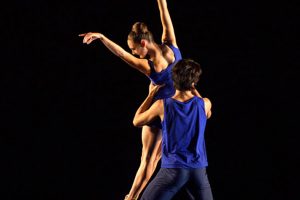
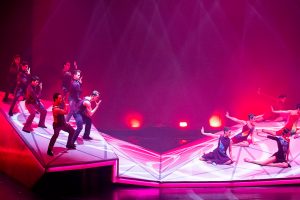



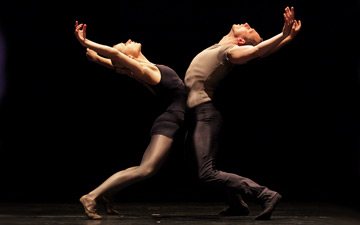

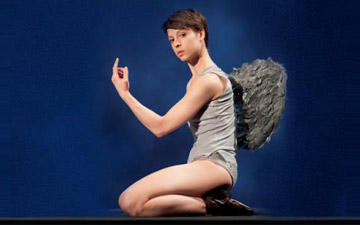
You must be logged in to post a comment.